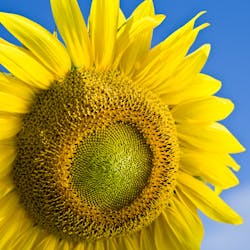Cambridge, MA--In a surprising application of biomimetics, researchers at the Massachusetts Institute of Technology (MIT) in collaboration with RWTH Aachen University (Aachen, Germany) have developed a concentrated solar power (CSP) design that reduces the amount of land required to build a CSP plant, while increasing the amount of sunlight its mirrors collect. By rearranging the mirrors, or heliostats, in a pattern similar to the spirals on the face of a sunflower, they could reduce the CSP footprint by 20% and increase its potential energy generation. The pattern apparently minimizes heliostat shading and blocking by neighboring mirrors. The research is published in the journal Solar Energy, and the researchers have filed for patent protection.
Typical CSP plants have mirrors arranged around the central tower in concentric circles. The spacing between mirrors is similar to the seats in a movie theater, staggered so that every other row is aligned. However, this pattern results in higher-than-necessary shadowing and blocking throughout the day, reducing the reflection of light from mirrors to the tower.
The lab of Alexander Mitsos and the Aachen collaborators developed a computational model to evaluate the efficiency of heliostat layouts, dividing each mirror into discrete sections and calculating the amount of light each section reflects at any given moment. The researchers then tested the model on an existing commercial-scale CSP plant and found that the CSP plant experiences a significant amount of shading and blocking each day despite the staggered layout of its mirrors. The team then tinkered with the pattern of heliostats, using numerical optimization to first bring the fanned-out layout closer together, and found that the resulting patterns had some spiral elements similar to layouts in nature.
Knowing that the florets of a sunflower are arranged in a spiraling pattern known as a Fermat spiral that appears in many natural objects and has long fascinated mathematicians, the researchers devised a spiral field with its heliostats rearranged to resemble a sunflower, with each mirror angled about 137 degrees relative to its neighbor. The numerically optimized layout takes up 20% less space than the original layout and reduces shading and blocking and increases total efficiency.
"Concentrated solar thermal energy needs huge areas," Mitsos says. "If we're talking about going to 100 percent or even 10 percent renewables, we will need huge areas, so we better use them efficiently."
Frank Burkholder, an engineer with the National Renewable Energy Laboratory, says for expensive heliostat fields, Mitsos' model could potentially generate the same annual energy by taking up "far less" land area.
SOURCE: MIT; http://web.mit.edu/newsoffice/2012/sunflower-concentrated-solar-0111.html

